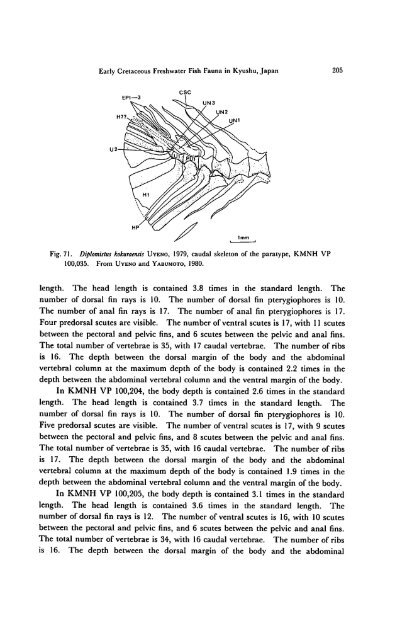Early Cretaceous Freshwater Fish Fauna in Kyushu, Japan
Early Cretaceous Freshwater Fish Fauna in Kyushu, Japan
Early Cretaceous Freshwater Fish Fauna in Kyushu, Japan
You also want an ePaper? Increase the reach of your titles
YUMPU automatically turns print PDFs into web optimized ePapers that Google loves.
<strong>Early</strong> <strong>Cretaceous</strong> <strong>Freshwater</strong> <strong>Fish</strong> <strong>Fauna</strong> <strong>in</strong> <strong>Kyushu</strong>, <strong>Japan</strong> 205<br />
EP1—3<br />
CSC<br />
Fig. 71.<br />
Diplomistus kokuraensis Uyeno, 1979, caudal skeleton of the paratype, KMNH VP<br />
100,035. From Uyeno and Yabumoto, 1980.<br />
length. The head length is conta<strong>in</strong>ed 3.8 times <strong>in</strong> the standard length. The<br />
number of dorsal f<strong>in</strong> rays is 10. The number of dorsal f<strong>in</strong> pterygiophores is 10.<br />
The number of anal f<strong>in</strong> rays is 17. The number of anal f<strong>in</strong> pterygiophores is 17.<br />
Four predorsal scutes are visible. The number of ventral scutes is 17, with 11 scutes<br />
between the pectoral and pelvic f<strong>in</strong>s, and 6 scutes between the pelvic and anal f<strong>in</strong>s.<br />
The total number of vertebrae is 35, with 17 caudal vertebrae. The number of ribs<br />
is 16. The depth between the dorsal marg<strong>in</strong> of the body and the abdom<strong>in</strong>al<br />
vertebral column at the maximum depth of the body is conta<strong>in</strong>ed 2.2 times <strong>in</strong> the<br />
depth between the abdom<strong>in</strong>al vertebral column and the ventral marg<strong>in</strong> of the body.<br />
In KMNH VP 100,204, the body depth is conta<strong>in</strong>ed 2.6 times <strong>in</strong> the standard<br />
length. The head length is conta<strong>in</strong>ed 3.7 times <strong>in</strong> the standard length. The<br />
number of dorsal f<strong>in</strong> rays is 10. The number of dorsal f<strong>in</strong> pterygiophores is 10.<br />
Five predorsal scutes are visible. The number of ventral scutes is 17, with 9 scutes<br />
between the pectoral and pelvic f<strong>in</strong>s, and 8 scutes between the pelvic and anal f<strong>in</strong>s.<br />
The total number of vertebrae is 35, with 16 caudal vertebrae. The number of ribs<br />
is 17. The depth between the dorsal marg<strong>in</strong> of the body and the abdom<strong>in</strong>al<br />
vertebral column at the maximum depth of the body is conta<strong>in</strong>ed 1.9 times <strong>in</strong> the<br />
depth between the abdom<strong>in</strong>al vertebral column and the ventral marg<strong>in</strong> of the body.<br />
In KMNH VP 100,205, the body depth is conta<strong>in</strong>ed 3.1 times <strong>in</strong> the standard<br />
length. The head length is conta<strong>in</strong>ed 3.6 times <strong>in</strong> the standard length. The<br />
number of dorsal f<strong>in</strong> rays is 12. The number of ventral scutes is 16, with 10 scutes<br />
between the pectoral and pelvic f<strong>in</strong>s, and 6 scutes between the pelvic and anal f<strong>in</strong>s.<br />
The total number of vertebrae is 34, with 16 caudal vertebrae. The number of ribs<br />
is 16. The depth between the dorsal marg<strong>in</strong> of the body and the abdom<strong>in</strong>al

















